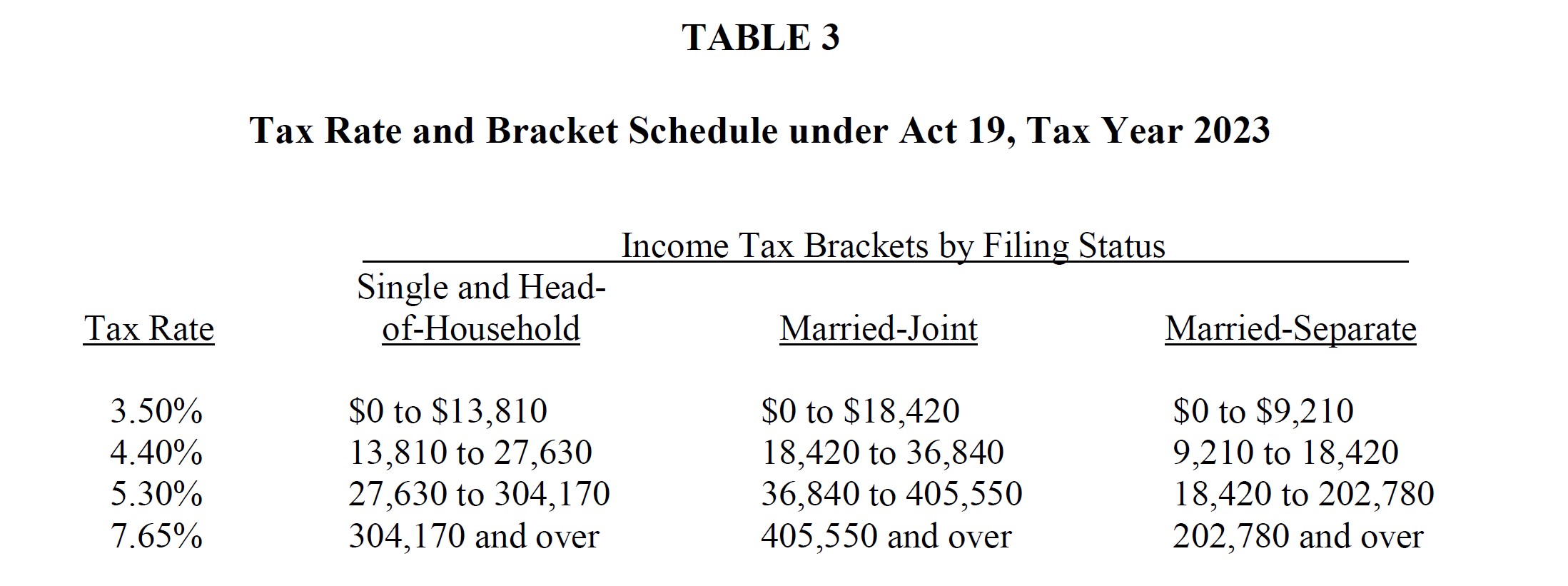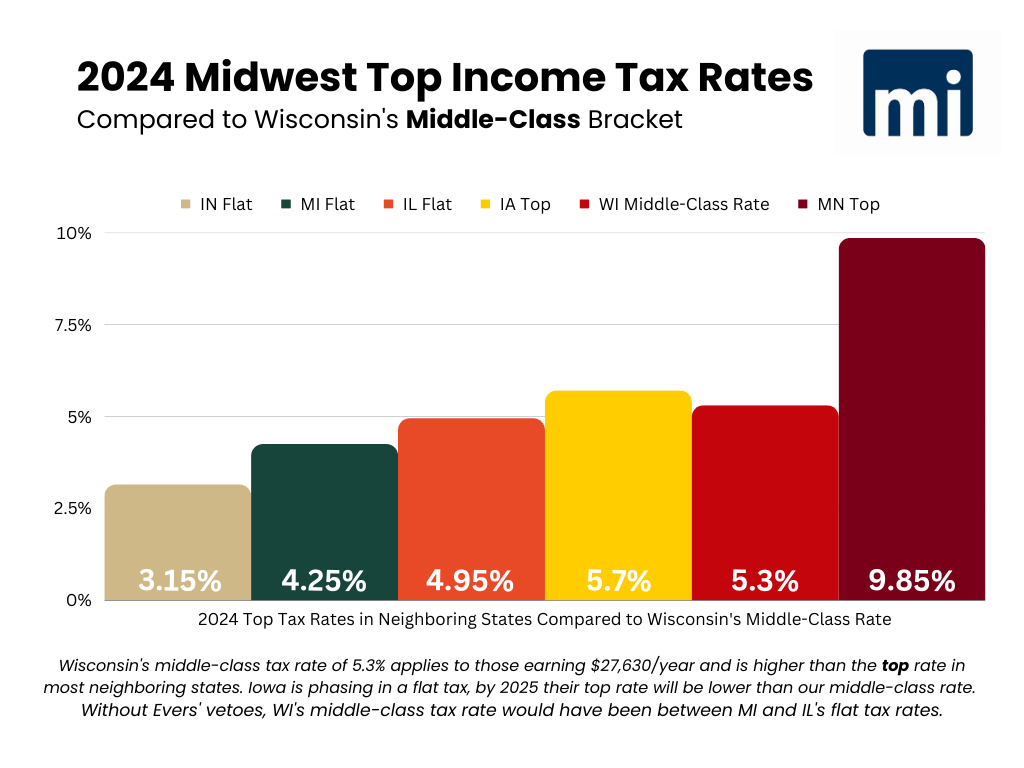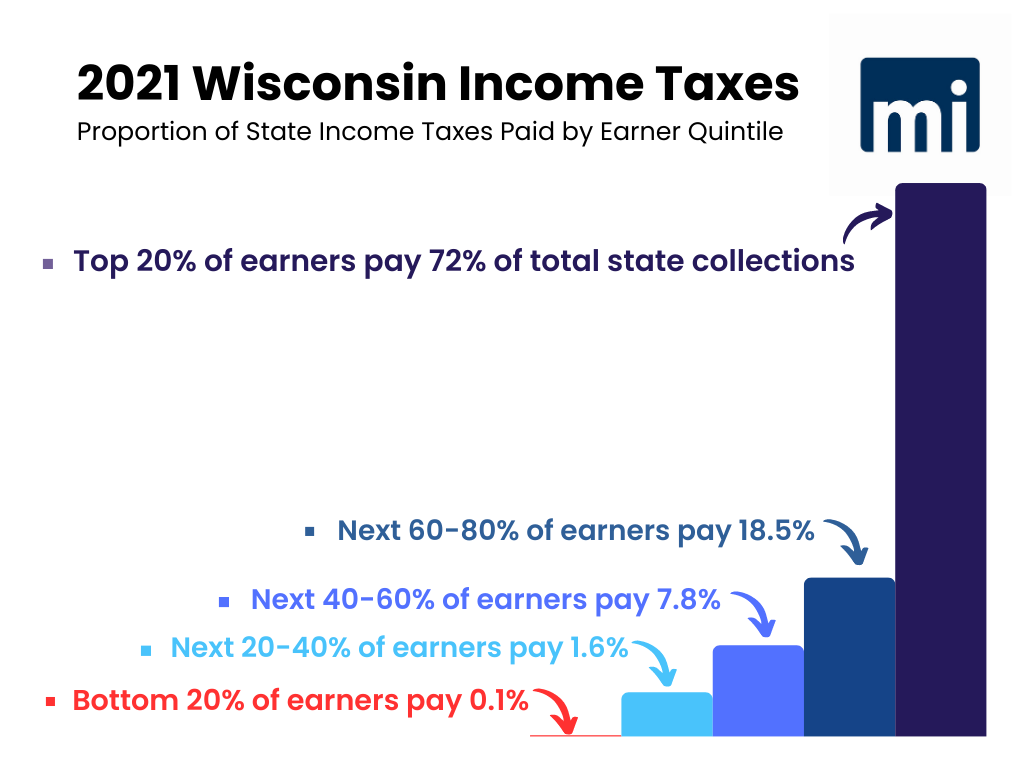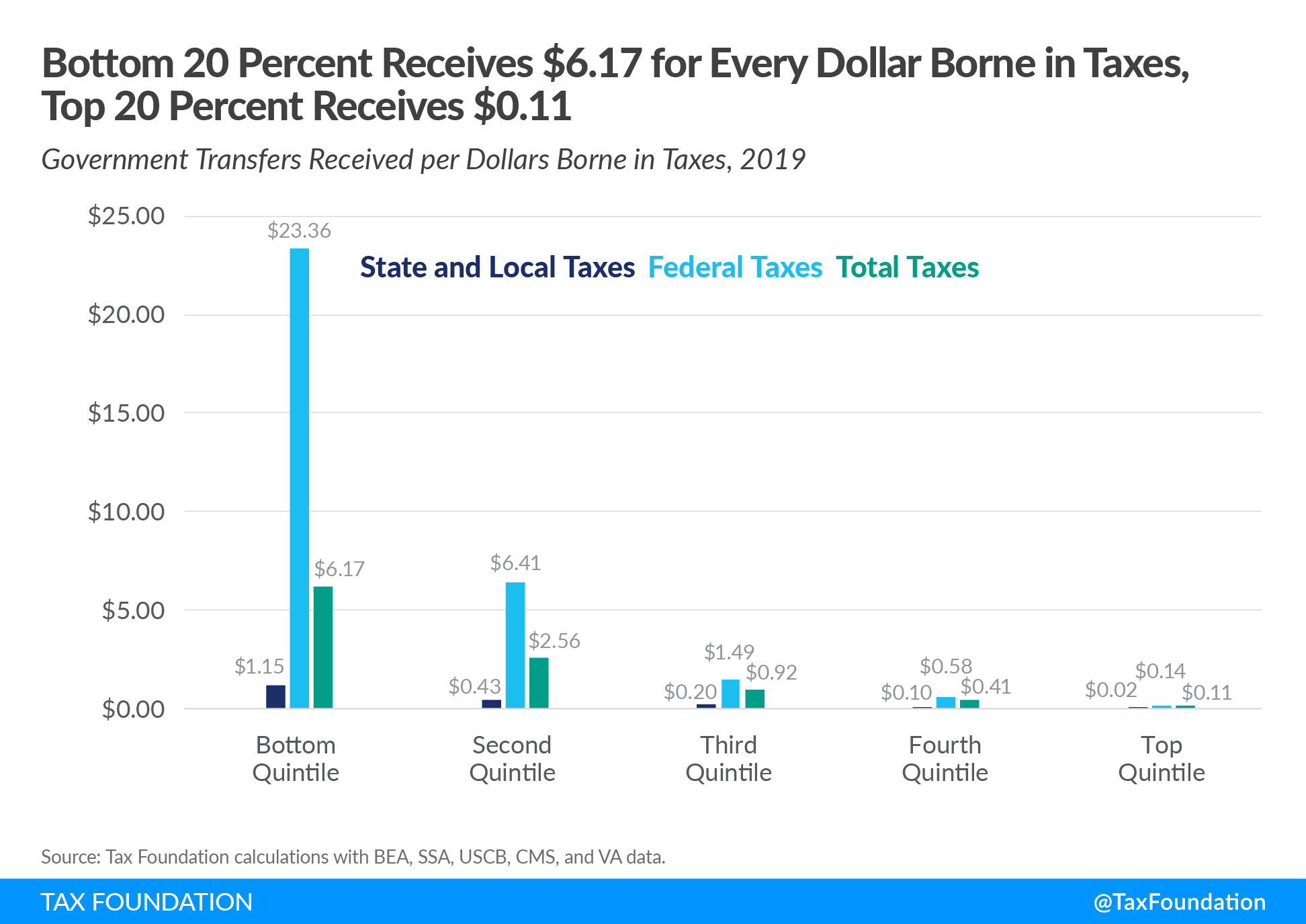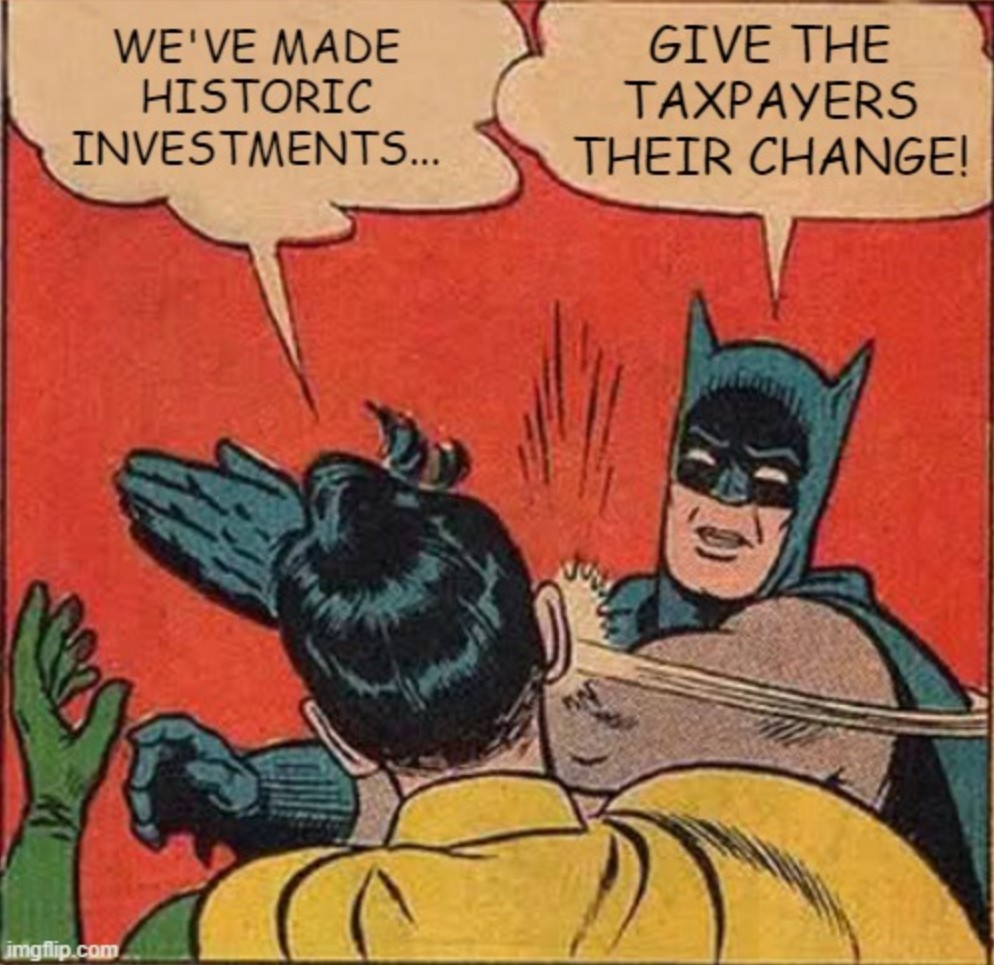
It’s Time to Give The Surplus Back
- Wisconsin income tax payers got back only 2.5% of the record $7 billion surplus. Record spending took the surplus down to $4 billion.
- Wisconsin’s middle-class tax rate is higher than the top rate in most neighboring states. The tax cut Evers vetoed would only have put our middle-class rate in the middle of our neighbors’ top rates.
- Evers says he wants a bigger tax cut but refuses to cut the middle-class rate bracket. He will withhold tax cuts from the middle-class to make sure high earners don’t pay less.
- Evers instead wants to dole out credits to select groups.
- The legislature should resist caving in to Evers, and instead negotiate for real income tax cuts for the people that built the surplus.
Taxpayers Never Said ‘Keep The Change’
We’ve all gotten the wrong change at one time or another – maybe you handed the cashier a $20 bill and you got change for a $10? That’s where Wisconsin taxpayers are now. They expected their change – the $7 billion tax surplus – to be returned to them but instead they got $175 million, and it looks like their elected officials may keep the change.
Worse, those leaders have already spent some of it; the $7 billion surplus is down to $4 billion.
Since the budget was signed, both the governor and the legislature have said they want larger tax cuts while offering little hope one is in the offing. This new posturing follows months of similar pretenses throughout the budget cycle.
It strains credibility to believe either side was particularly committed to an actual, substantive tax cut during the budget cycle.
First, Evers proposed a budget spending a record $106.3 billion, with a net tax increase of over $100 million and providing “tax cuts” largely in the form of tax shifts – credits that provide tax relief (in some cases welfare payments) for some, using tax dollars paid by others – while the state had a record $7 billion tax surplus.
The legislature followed Evers’ lead, prioritizing spending increases (and a huge sales tax increase for our largest city and county) in their negotiations with the governor, with virtually no attention, and even less negotiation, on giving taxpayers back the surplus that belonged to them.
In the final hours of the biennium, eager to wrap work and start victory laps on their massive spending increases, the legislature tossed an income tax cut plan into the budget that the governor was sure to veto. Was it a serious plan? It depends on what you mean by serious. It would have provided serious tax relief and put the state in a more competitive position as well as on the path to a flat, fair income tax. No one seriously believed the governor would sign off on a tax cut that nobody had mentioned to him much less negotiated, but the expected veto would provide a serious opportunity to lob shots at the governor.
And the governor did veto 95% of the tax cut, including a very substantive, meaningful cut to the middle-class tax bracket.
So, it strains credibility to believe either side was particularly committed to an actual, substantive tax cut during the budget cycle.
Gaslighting Us About Our Change
Evers and legislative leaders continue to say they want to cut taxes. But a closer look at what each side is saying makes a real cut seem incredibly unlikely.
Evers says he wants “his” tax cuts, which do nothing to cut the overall tax burden but instead provide credits/welfare payments to select groups, some who pay no taxes. He said he won’t consider anything similar to what the legislature proposed, nor would he consider changes to just the middle-class bracket.
In other words, Evers will not consider a permanent tax rate cut for the middle class.
Legislative leaders plan an override attempt which is all but certain to fail lacking a 2/3 majority in the Assembly. They could come back with another tax cut plan this fall if they don’t spend the surplus on other priorities.
Worse Than Not Getting Our Change
The worst-case scenario isn’t that Madison keeps our change, it’s that they spend it – on top of the already-excessive level of budget spending.
Next worse? The legislature abandons large, across-the-board rate reductions, capitulates to Evers’ definition of a tax cut and delivers another big slug of spending and tax shifts they sell as a cut.
Either scenario is possible – even likely – and that’s the danger. This session has revealed to Wisconsinites a legislature overwhelmingly dedicated to bigger government and higher spending, setting a record with an 11.4% increase.
In the past 30 years the state budget has tripled, while the median household income has only doubled. In 19 of those years Republicans controlled both houses of the legislature (and therefore control of the “powerful Joint Finance Committee”), while Democrats controlled both houses only 2 years.
While other states around the nation used their (smaller) surpluses for (larger) meaningful tax cuts, the top priority of our legislature was jacking up spending and teeing up a $266 million-a-year tax hike for Milwaukee, who were so glad to be bailed out they left flaming bags of excrement on the legislature’s front porch.
Evers Denied the Middle-Class a Tax Cut
In rejecting the legislature’s combining of the middle two income brackets, Evers demonstrated just how little interest he has in cutting income tax rates for those in the middle class. Our second-highest bracket starts at $27,630 and covers the entire “middle-class,” typically defined as between two-thirds and 2 times the median household income which is just under $70,000/ year in Wisconsin.
Our middle-class tax rate will remain at 5.3% because Evers vetoed the legislature’s proposed reduction for the bracket to 4.4%.
For comparison, most of our neighboring states have or are moving to a flat tax structure, and as the graphic below demonstrates, their top tax rates for 2024 are lower than our middle-class tax rate of 5.3%. Thanks to Evers’ tax cut veto, in 2025 every middle-class worker in Wisconsin will face a higher tax rate than the wealthiest 11 millionaires in Iowa, Illinois, Indiana and Michigan.
If Evers had been serious about targeting the middle class, he could have signed into law the rate cut from 5.3% to 4.4% in the bracket that contains every single middle-class earner in Wisconsin. But he didn’t.
Evers would rather cheat the middle-class out of their change than to let the rich get their change back.
Cutting Off Middle Class Tax Cuts to Spite the Rich
When Evers says “middle-class tax cuts” a lot of what he means is welfare. It’s worth noting that Evers did not propose a tax rate cut in his budget, just a slew of credits to specific groups that he calls tax cuts.
Why not just cut tax rates? Why not give all taxpayers their change?
Because Evers’ tax policy is best summed up like this: all-out efforts to deny substantive, permanent income tax cuts for the lower half of earners purely to make sure the upper half doesn’t get some too.
Our tax structure makes it impossible to cut income tax rates in any income bracket without people in higher brackets (who earn more and pay more taxes) getting a bigger tax reduction. Progressivity deliberately creates imbalance and inequity by taxing people at higher and higher rates as they earn more.
Wisconsin’s progressive tax structure means the top 1% of earners pay 203 times more than the bottom 20% of earners combined.
The bottom 60% of taxpayers combined pay about 40% of what the top 1% pay. Wisconsin is in no danger of letting the mega-rich off the hook even with a much, much, MUCH larger tax cut than the one the legislature proposed, although Evers’ rhetoric is designed to create that canard.
If we can never cut taxes for the people who pay most of the taxes, revenues stay high, and spending can go higher. The left is deeply invested in keeping our tax structure as inequitable as possible and the right has become addicted to growing government and hiking spending. That spells bad news for taxpayers.
Evers doesn’t acknowledge it, the mainstream media would never mention it, and the rank-and-file on the left don’t understand it – but when Evers vetoed away 95% of the legislature’s income tax cut, he still reduced taxes more for the wealthiest, jet-setting, super-rich millionaires in the state more than he did for the lowest income taxpayers.
Yet somehow, we aren’t seeing headlines screeching: “Pennies for the Poor: Evers tax cuts give the 24,000 poorest taxpayers one buck while the 25,000 richest see 47 times more.”
Wisconsin has one of the most progressive tax structures in the nation, becoming more of an outlier every day as more states cut taxes and flatten their structures. We have long touted the benefits of a fair, flat tax where a taxpayer that makes 10 times more than another taxpayer pays 10 times more in taxes. Not 100 times more, or 500 times more. It’s not only more equitable, it’s more competitive, and we are losing ground to the other states that have recognized the benefits of a flat tax.
Giving Our Change Away
Progressive tax rates only tell part of the story in terms of the level of tax burden income groups bear. A Tax Foundation report from March 2023 examined tax burdens in terms of both taxes paid by as well as government income transfers to households. Transfers include welfare programs like Medicaid, Medicare, Social Security and Disability, Housing Assistance, Community Services, and Unemployment.
They found that for every dollar paid in federal, state, and local taxes, the bottom 20% of taxpayers receives $6.17. The top 20% receives $0.11 for every dollar paid in taxes, much of that due to Medicare and Social Security. Taxpayers in the middle 20% get back less than they pay in too; for every tax dollar they pay, they get back 92 cents. This group doesn’t need a study or charts to know this – ask any middle-income earner and they know they don’t get back what they put in and that their change is being handed to someone else.
With the 9th highest top tax bracket, the 21st lowest median household income, extremely generous welfare benefits and one of the top 10 largest gaps between our top rate and the rate for someone making $25,000, Wisconsin almost surely has greater disparities in this tax-and-transfer differential.
Better to Bank the Surplus than Phony Tax Cuts
When Evers says he wants the legislature to come back with a different tax cut plan, what he means is that he wants more welfare; he wants to pick and choose winners and losers to give credits that amount to welfare. Evers wants to sink hundreds of millions into things like childcare subsidies, low-income housing, and electric vehicle charging credits. If you’re a middle-income earner, who drives a regular car and you’re childless or your children have left home – your change is going to fund credits for other people.
He’s comfortable refusing to cut even the middle-class tax rate because he is betting the legislature will be so eager for a bigger tax cut that they’ll agree to his slate of special credits and tax shifts and give up on real tax cuts.
If Evers truly cares about the middle class, he will step back and reexamine these lines in the sand.
For their part, legislators should call Evers’ bluff, swallow their pride, and try to negotiate a meaningful, broad tax rate cut, moving the state toward a flat tax, returning the surplus to the taxpayers who built it, not spending it, not caving in and giving tax credits to only some of the taxpayers who paid more than our bloated government could spend.
Taxpayers – all of them – have been waiting too long for their change.
